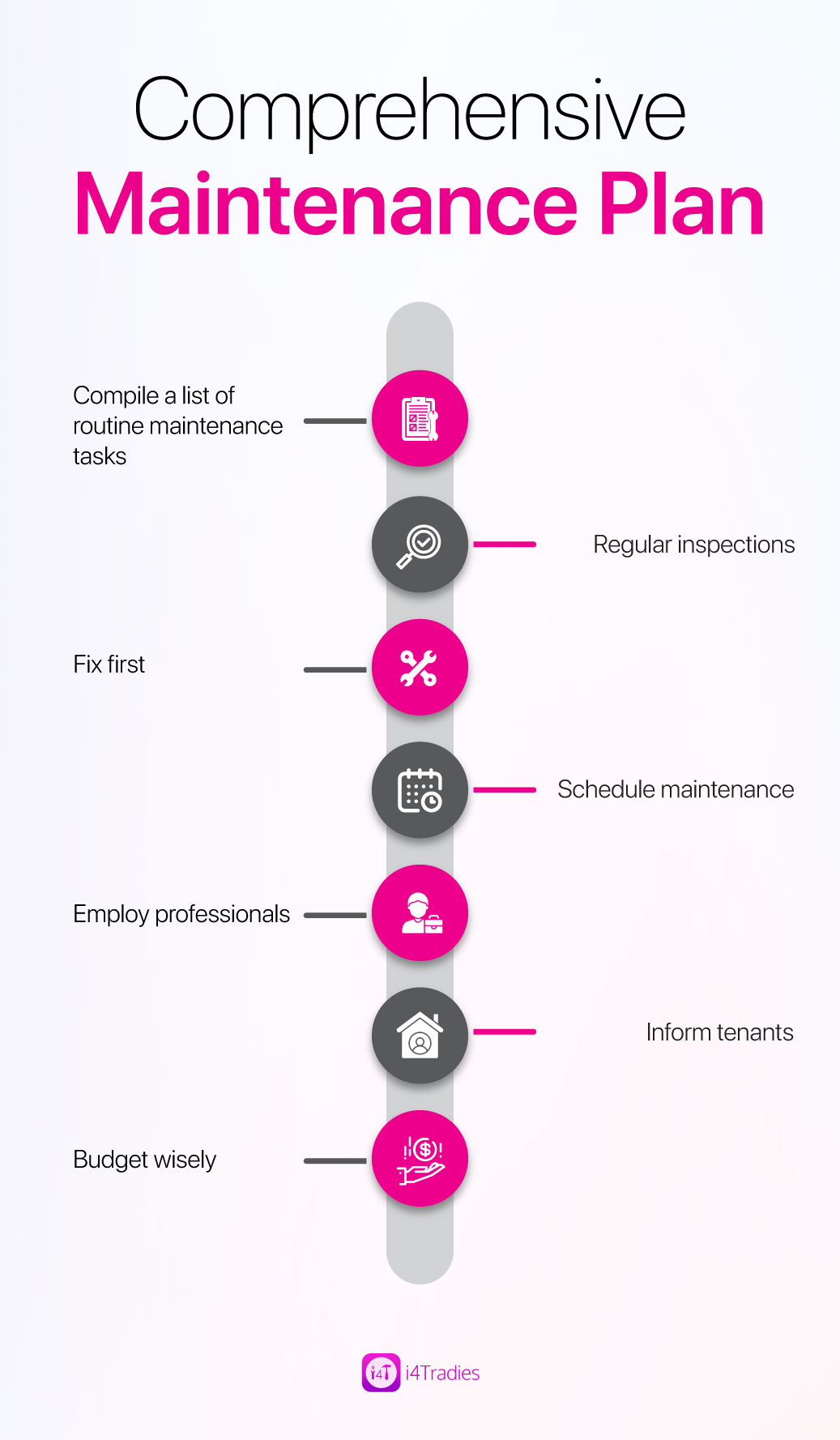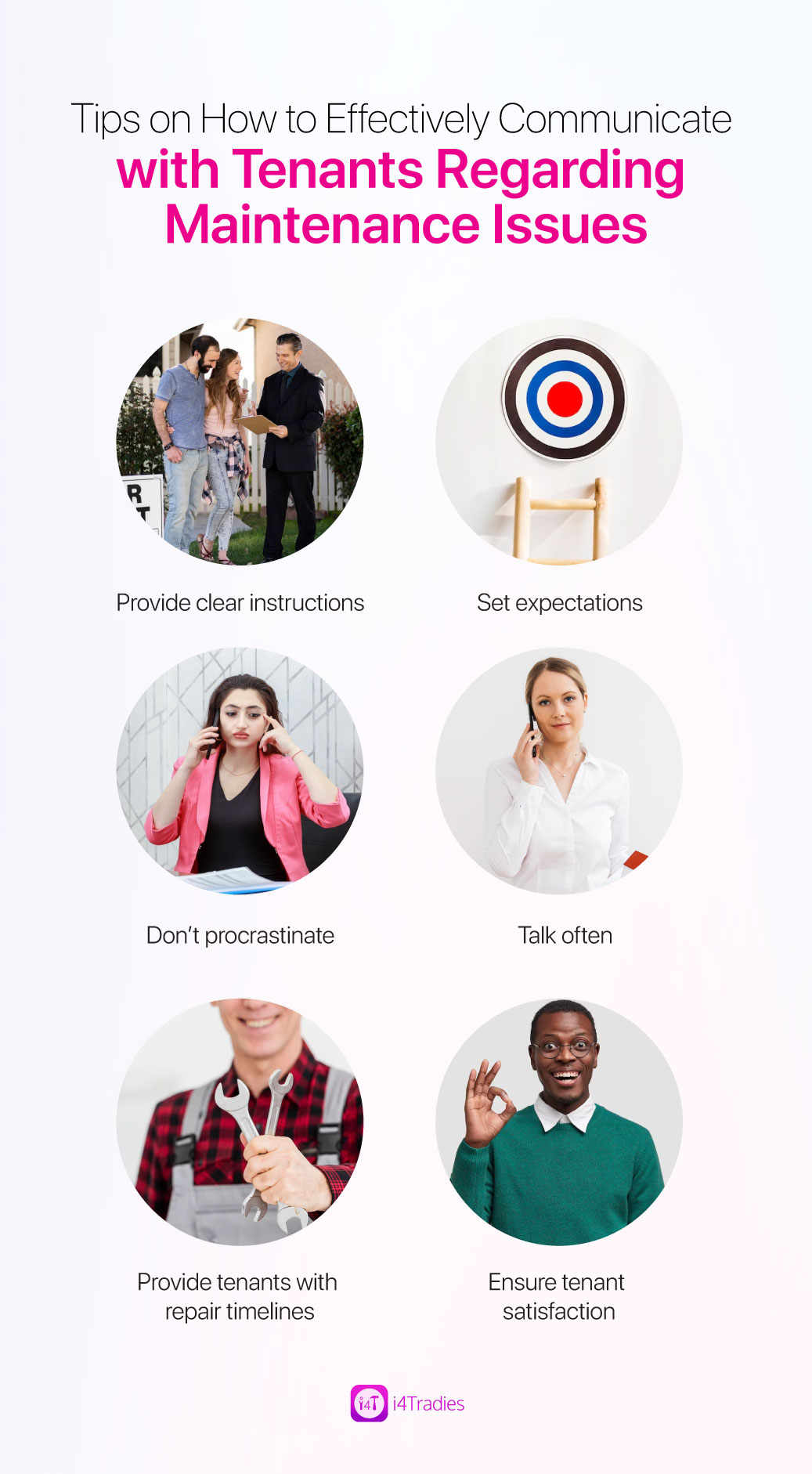One of the most significant challenges landlords face is managing repairs and maintenance in rental property.
From responding to maintenance requests to scheduling repairs and hiring contractors, there are many moving parts to keep track of in your rental property.
However, with the right strategies and tools, landlords can streamline their repairs and maintenance processes and save time and money in the long run. In this blog post, we’ll share tips and best practices for landlords to optimize their maintenance and repair workflows.
The article will also discuss how to use technology to improve efficiency and develop preventive maintenance plans to avoid costly repairs down the line. These tips can help you take the repairs and maintenance in rental properties to the next level.
Establishing a maintenance plan: Setting goals and priorities
Developing a comprehensive maintenance plan for your property is essential to ensure that it remains in good condition and retains its value over time.
Here are some steps you can follow to create a comprehensive maintenance plan:

- Compile a list of routine maintenance tasks: Include all the regular maintenance tasks needed to maintain the property. Changing air filters, cleaning gutters, checking the roof and plumbing for leaks, and testing smoke detectors.
- Regular inspections: Check the property often to keep up with the issues. Depending on the property size, you may inspect every six months or annually. Inspect for wear, damage, and safety issues.
- Fix first: Prioritize repairs after inspections. List immediate, delayed, and deferred repairs.
- Schedule maintenance: Schedule inspections, repairs, and routine maintenance.
- Employ professionals: Hire licensed professionals for any maintenance work like plumbing or electrical repairs.
- Inform tenants: Inform the tenants about the maintenance schedule, including routine inspections and repairs. Promote prompt maintenance reporting.
- Budget wisely: Budget for routine and unexpected maintenance. This will help you pay for upkeep as needed.
Communicating with tenants: Establishing expectations and feedback mechanisms

As a landlord, it’s essential to communicate effectively with your tenants regarding maintenance issues.
Clear communication helps ensure that tenants understand their responsibilities and the expectations you have from them.
This can lead to a more positive and successful rental experience. Here are some tips on how to effectively communicate with tenants regarding maintenance issues:
- Provide clear instructions: When talking with tenants about maintenance issues, make sure they know what to do if they discover something that requires repair. This could contain a phone number or email address for reporting concerns and the best time to contact you.
- Set expectations: Give tenants maintenance expectations. If you want tenants to clean or update air filters, say so.
- Don’t procrastinate: Respond quickly and fix maintenance issues reported by tenants. This builds tenant trust and shows your commitment to property maintenance.
- Talk often: Send maintenance updates or reminders. This may include seasonal maintenance or inspections.
- Provide tenants with repair timelines: Communicate any delays or timeline modifications immediately.
- Ensure tenant satisfaction: After repairs, check with tenants to make sure they’re happy. This builds trust and shows you care about their concerns.
Working with contractors: Finding the right professionals for your needs
When repairs and maintenance in rental property require the services of a contractor, landlords should ensure that they work with reputable professionals.
Landlords should research potential contractors and check their references and credentials. Additionally, they should establish clear expectations and timelines for the work to be done.
You should also establish a contract with the contractor outlining the work scope, timelines, and costs. This contract should include provisions for addressing any issues or disputes arising during the project.
You can search the web to find a reputable contractor near you. With i4Tradies you can easily find licensed and reputable contractors in your area. You can easily contact a Field Service Supplier and discuss the requirements so that both parties can get into a contract.
Prioritizing maintenance tasks: Dealing with emergencies and preventive maintenance
As a landlord, it’s crucial to prioritize maintenance tasks in rental properties. This is to ensure that the property remains in good condition and that tenants are safe and comfortable. Here are some tips on how to prioritize maintenance tasks based on urgency and importance:
- Start with urgent maintenance, including broken water pipes, electrical difficulties, and gas leaks. These problems can endanger lives or harm property.
- Address safety: After resolving immediate issues, address safety hazards, including a loose handrail, broken window, or damaged flooring. These flaws can endanger tenants and should be rectified immediately.
- Habitability issues: Fix faulty appliances, HVAC systems, and water heaters. Addressing these concerns immediately can improve tenants’ living conditions.
- Fix operational issues: Problems like leaking roofs, blocked gutters, and broken doors and windows can render the property unsafe and non-functional. Fixing these issues quickly can prevent harm to the property.
- Improve appearance: Fix cosmetic issues like peeling paint or old carpeting. These flaws may not affect property functionality but can affect value and make the property less attractive for current and potential tenants.
Implementing preventive maintenance: Strategies for avoiding costly repairs
Implementing preventive maintenance measures is essential to avoiding costly repairs and extending the lifespan of your rental property’s systems and appliances. Some simple steps include creating a maintenance schedule that outlines regular inspections, cleaning, and servicing of systems and appliances. This can include HVAC systems, water heaters, and kitchen appliances.
It is also important to stay on top of small repairs before they become bigger problems. This might include fixing leaky faucets, replacing worn weather-stripping around doors and windows, and addressing small cracks or holes in walls or flooring.
By taking a proactive approach to maintenance, you can save money on costly repairs and replacements over time. This will also ensure that your rental property remains safe and comfortable for tenants.
Tracking and analyzing maintenance data: Using technology to streamline the process
Landlords can use technology to upkeep their properties all year round. This can include using software or apps to track maintenance requests, schedules, and costs.
If you use the i4Tradies app, you can monitor the progress of your jobs in real-time. By analyzing maintenance data, landlords can identify patterns and trends to help them make informed decisions about repairs and maintenance in rental property.
You can identify trends in maintenance requests and pinpoint areas that may require more attention or resources. Further, you can also identify areas to improve the maintenance strategies and reduce costs.
Reducing maintenance costs: Tips for maximizing efficiency and saving money

Bargain with contractors for repairs and maintenance in rental property: Try to get the best pricing. This may involve requesting many contractors to match or beat each other’s prices. Long-term relationships with reliable contractors might help to get better pricing. However, remember, if the price variation is too much from one supplier to the other, there might be a difference in service quality as well.
Bulk-buy maintenance supplies including air filters, light bulbs, and cleaning products to save money. Consider a purchasing cooperative with other landlords or supplier discounts.
Using technologies like Home Maintenance Management software can boost efficiency and lower expenses. Apps like i4Tradies can track maintenance requests, automate tenant and contractor communication, and streamline maintenance schedules.
Educate tenants on essential maintenance: Teaching tenants how to change air filters and clean gutters can decrease the need for more significant repairs. You can promote responsibility and offer tenants a maintenance checklist.
Conclusion
Proactive repairs and maintenance are critical to ensuring that rental properties are in good condition and tenants are satisfied.
As mentioned before, you can visit i4Tradies to find reliable contractors in your area. We have helped many landlords find Field Service Suppliers through our website and application for many years. You can quickly contact the professional through our portal and track your job in real time. So what are you waiting for? Request a quote through i4Tradies and get on with the repairs and maintenance of the rental property.
FAQs
How often should I perform routine maintenance on my rental property?
Routine maintenance should be performed every 3–6 months to prevent major issues.
What is the best way to communicate with tenants about maintenance issues?
Provide them with a clear and convenient method of reporting problems, such as an online portal or dedicated phone line. Respond to their requests promptly and professionally.
How can I hire reliable contractors for repairs and maintenance?
Ask for referrals from friends and family, check online reviews and ratings, and verify their license and insurance certificates. Further, obtain multiple quotes before making a final decision. Or else you can visit i4Tradies to find a list of reliable contractors in your area.
What is preventive maintenance, and how can it benefit my rental property?
Preventative maintenance comprises scheduled inspections and repairs to prevent any issues. This can save costly repairs and downtime, extend your rental property’s components’ lifespan, and improve tenant happiness.
How can I reduce the cost of repairs and maintenance in my rental property?
- Perform frequent inspections and address concerns quickly.
- Invest in high-quality materials and equipment.
- Obtain volume discounts with contractors.
- Encourage tenants to report problems early to avoid costly repairs.












